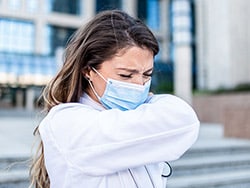Hospitals around the country struggled with the overlapping illness seasons of COVID-19, respiratory syncytial virus (RSV), and influenza last year making up a "tripledemic." Physicians and patients alike suffered under the strain of resource and personnel shortages. As a result, many clinicians weighed up the wisdom and consequences of going into work even when they were ill.

This year as well, the threat of a tripledemic looms and many clinics, hospitals, and medical offices remain short-staffed, leaving doctors to struggle with their approach to working while sick. Some have a personal philosophy of staying home while ill to prevent any potential spread, whereas others feel the need to show up under most circumstances. The decisions often relate to where you work or in which department.
"As a former emergency medicine physician, it didn't matter if I was actively vomiting with the flu, I had to go to work," said Danielle Kelvas, MD, CEO and founder of DKMD Consulting, based in Chattanooga, Tennessee. "Rarely is there someone available to replace you, depending on how large your group or practice is."
Benjamin Jack, MD, is an emergency physician and founder/CEO of Duration Health, in New York. He, too, reports to work through illness if he is physically able. "As an ER doctor, I tend to wait out minor illnesses because I can usually tell if an issue is serious," he said. "Most minor conditions improve without intervention. When necessary, I'll use my medical knowledge to self-treat or consult a colleague if it's something outside my area. For anything more complex, I seek another doctor's care."
In contrast, Robert Miller, MD, doctor of internal medicine with Vista Staffing, makes staying home while ill a priority. "Taking care of the public starts with taking care of myself," he said. "I keep that in mind all the time. This extends to my fellow staff members, too, because their health matters as well.
It's a dilemma that all physicians face at one time or another, and figuring out your approach will depend on employer guidelines, personal philosophies, and — in today's healthcare landscape — whether or not your facility is fully staffed, too.
Feeling the Pressure
Without question, the COVID-19 pandemic put pressures on doctors like never before. With overflowing hospitals and fellow staff members absent from work owing to illness, many physicians felt they had no choice but to show up for work if they were physically able. Prior to that, however, doctors still got sick with other illnesses and had to decide when to come in or whether to sit it out.
A 2015 JAMA report, "Reasons Why Physicians and Advanced Practice Clinicians Work While Sick," explored why doctors still showed up when ill. The researchers performed a mixed-methods analysis of a cross-sectional, anonymous survey at a large children's hospital in Philadelphia. Nearly 460 attending physicians and other healthcare workers responded to the questions presented.
Of those surveyed, 95% believed that working while sick put patients at risk. Despite this belief, 83% of the respondents reported working sick at least one time over the prior year, and 9% reported working while sick at least five times in that same period.
This practice can indeed put patients' health at risk, according to the survey, which linked numerous reports of outbreaks that could possibly be traced to symptomatic healthcare workers. Some cases of flu, staph infections, norovirus, and pertussis were documented outbreaks originating from a sick healthcare worker. These associations have led to increased morbidity and mortality, as well as excess costs. This is especially true in cases where healthcare workers have exposed immunocompromised patients to a pathogen.
Although all physicians understand the risks of working while sick, many feel boxed in by their institutions or departments. According to the JAMA report, "The decision to work sick is shaped by systems-level and sociocultural factors. Multimodal interventions are needed to reduce the frequency of this behavior."
The lack of full staffing as a factor holds true in Jack's case. "If I'm not too sick to function, I'll go into work," he said. "My job requires a high level of commitment, and there's often no backup if I'm out."
Kelvas said that since the pandemic, the "sick work" culture has improved as a whole, but it still doesn't allow healthcare workers to stay home. "During the pandemic I switched to primary outpatient care, and I naturally contracted COVID," she said. "Although sick as a dog, I was still seeing patients via Zoom between naps and coughing fits."
While working remotely clears up the issue of potential transmission to patients and coworkers, it doesn't allow doctors the rest they need to return to the workplace at 100%. "Do I agree with this culture?" asked Kelvas. "Absolutely not. It's barbaric, and it's why I no longer work in direct patient care."
Sit It Out, If Possible
Although doctors have always been aware of infectious disease prevention measures, the pandemic again drove home the need for those steps. Miller is especially conscious of the actions he can take to remain healthy. "I stay up to date with all my vaccines and any individual health screenings for my age group," he said. "I stay lean and fit; eat well; stay hydrated; and do all the simple things like wearing gloves, washing hands, and masking up."
When Miller does feel ill, he takes immediate action. "If I feel a headache coming on or if I'm feeling a little off, I'll reach out to employee health to see if there are tests we can do," he said. "Many hospitals now have early testing so that you can stay on top of infection. I also keep a diary of symptoms, and if it seems like more than a common cold, I will self-isolate."
Should a virus test turn positive, Miller will take the steps necessary to treat it, whether with medication for influenza or 5 days at home for COVID. Because Miller travels to various institutions, he's developed this universal approach to his own healthcare. But, he added, "Many of these inpatient settings have similar guidelines, while outpatient settings may be different.
"It's an unfortunate reality that sometimes, healthcare workers are the last to seek healthcare," Miller continued. "It's easy to be blind to the risks because we see them every day and probably don't appreciate them as we should."
And even when physicians are fully aware the risks, sometimes their hands are tied. "Hospital sick leave policies generally assume there are additional personnel to fill in, an assumption that doesn't hold in many emergency departments," said Jack. "Given the staffing model in ERs, there's often no substitute physician on standby. Therefore, a policy on paper may not translate into practice when backups are nonexistent."
What the CDC Says
Since the COVID-19 pandemic began almost 4 years ago, the advice and guidelines issued by the Centers for Disease Control and Prevention (CDC) has evolved greatly. The most recent advice from the CDC on whether and how long you should isolate after SARS-CoV-2 infection reads like this:
Isolation can be discontinued at least 5 days after symptom onset (day 0 is the day symptoms appeared, and day 1 is the next full day thereafter) if fever has resolved for at least 24 hours (without taking fever-reducing medications) and other symptoms are improving.
A high-quality mask should be worn around others at home and in public through day 10. A test-based strategy may be used to remove a mask sooner.
The CDC has also established guidelines surrounding the flu, specific to going to a workplace:
All employees should stay home if they are sick until at least 24 hours after their fever (temperature of 100 degrees Fahrenheit or 37.8 degrees Celsius or higher) is gone. Temperature should be measured without the use of fever-reducing medicines (medicines that contains ibuprofen or acetaminophen). Note: Not everyone with flu will have a fever. Individuals with suspected or confirmed flu, who do not have a fever, should stay home from work at least 4-5 days after the onset of symptoms. Persons with the flu are most contagious during the first 3 days of their illness.
RSV guidelines regarding isolation and/or the workplace don't exist on the CDC's site, but because RSV spreads easily through the air as well as through touch, staying home once you're aware of symptoms and for the next 8 days is generally a good idea.




Comments